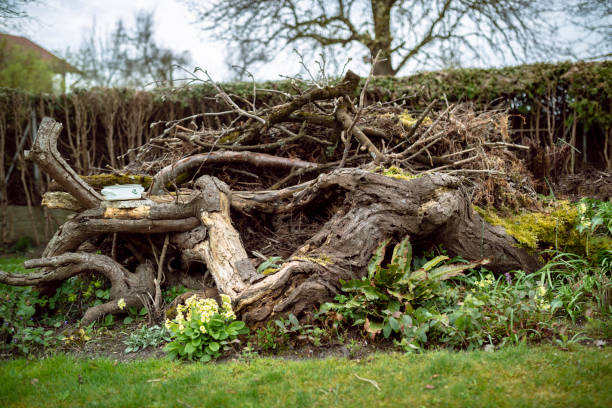
Trees are vital components of our ecosystem, providing shade, oxygen, and aesthetic beauty. However, even the hardest trees can succumb to disease, old age, or environmental stress. Recognizing the signs of a dying or dead tree is crucial for maintaining a healthy landscape. In this guide, we will explore essential signs that can help you determine if a tree is dead and offer tips on how to care for your trees.
1. Lack of Foliage
One of the most obvious signs that a tree might be dead is a lack of foliage. If a tree that should be in full leaf during the growing season is bare or has sparse leaves, it could indicate that the tree is dying or already dead. Once a dead tree is removed, homeowners often wonder what to plant after tree removal to restore greenery and maintain a balanced landscape. Choosing the right replacement plants can help improve soil health and enhance the property’s aesthetics. Keep an eye out for these warning signs:
- Leaves that do not appear during the growing season
- Leaves that are dry, brown, or brittle
- A significant portion of the tree that remains leafless
2. Trunk Damage
The condition of the trunk is a key indicator of a tree’s health. Look for:
- Cracks or splits in the trunk
- Deep cavities or holes
- Areas where bark is missing or peeling away
These signs often indicate internal damage or decay that can compromise the structural integrity of the tree.
3. Fungus Growth
Fungus growth on or around the tree is a strong indicator that the tree is in poor health. Fungal growth often appears as:
- Mushrooms or other fungi at the base of the tree
- Fungal growth on the trunk or branches
- Discolored or rotten wood beneath the bark
Fungi thrive on decaying wood, so their presence often signals advanced decay within the tree.
4. Vertical Cracks
Vertical cracks in the trunk or large branches can be a warning sign of a dying tree. These cracks may result from:
- Environmental stress such as extreme weather conditions
- Internal decay
- Structural weaknesses
Cracks weaken the tree and increase the risk of it falling.
5. Peeling Bark
Bark protects the tree from pests and diseases. If the bark is peeling or falling off, it could mean:
- The tree is unable to transport nutrients effectively
- The tree is suffering from disease or infestation
- There is significant internal damage
Healthy trees will have bark that is tough and not easily removed.
6. Sudden Leaning
A tree that suddenly starts to lean could be experiencing root damage or structural failure. This could be caused by:
- Soil erosion
- Root rot
- Structural imbalance due to pruning or natural growth patterns
If a tree leans more than 15 degrees from its vertical position, it is often a sign of root problems or other severe issues.


Quick Test to Confirm a Tree Is Dead
To confirm whether a tree is dead, you can perform a scratch test. This involves:
- Gently scraping away a small piece of bark with a knife.
- Observing the color of the underlying wood.
- If the wood beneath is green and moist, the tree is still alive.
- If the wood is brown and dry, the tree is likely dead.
How To Save A Dying Tree
If you notice your tree showing signs of distress but it’s not completely dead, you can take steps to save it:
- Watering: Ensure the tree receives adequate water, especially during dry spells.
- Mulching: Apply mulch around the base to retain moisture and regulate soil temperature.
- Pruning: Remove dead or diseased branches to prevent the spread of disease.
- Fertilizing: Provide the necessary nutrients through appropriate fertilizers.
- Pest Control: Address any pest infestations promptly with suitable treatments.
Tree Care Tips For Fall
Caring for trees in the fall is essential for their health and longevity. Here are some tips:
- Watering: Continue watering until the ground freezes.
- Mulching: Apply a fresh layer of mulch to protect roots from extreme temperatures.
- Pruning: Trim dead or weak branches to prevent winter damage.
- Inspection: Check for signs of disease or pest infestation and address them immediately.
Frequently Asked Questions
1. How do you tell if a tree is fully dead?
A fully dead tree will have no green under the bark, brittle branches, and a lack of leaves or buds. The wood will be dry and easily breakable.
2. What are the symptoms of a dead tree?
Symptoms include no foliage during the growing season, peeling bark, fungal growth, vertical cracks, trunk damage, and sudden leaning.
3. Can a dead tree be revived?
Once a tree is fully dead, it cannot be revived. However, early intervention when a tree is showing signs of stress can sometimes save it.
4. How to tell if a tree is unhealthy?
An unhealthy tree may show symptoms like discolored or misshapen leaves, dead branches, trunk damage, slow growth, and signs of disease or pest infestation.
Taking proactive measures and regular inspections according to the IAS guidelines can help to maintain the health and safety of your trees. If in doubt, consulting a professional arborist is always a wise decision to ensure the best care for your trees.

